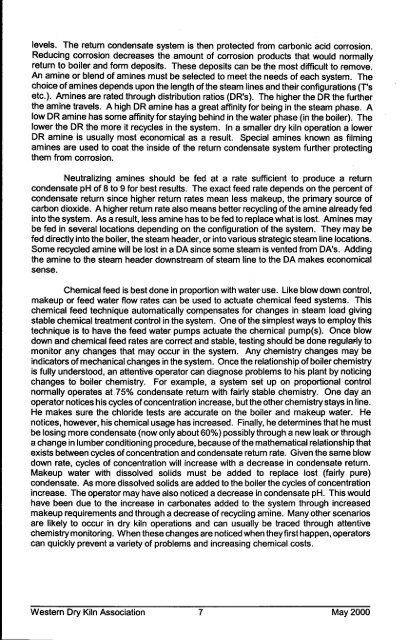BASIC WATER TREATMENT OF STEAM BOILERS
BASIC WATER TREATMENT OF STEAM BOILERS
BASIC WATER TREATMENT OF STEAM BOILERS
You also want an ePaper? Increase the reach of your titles
YUMPU automatically turns print PDFs into web optimized ePapers that Google loves.
levels. The return condensate system is then protected from carbonic acid corrosion.<br />
Reducing corrosion decreases the amount of corrosion products that would normally<br />
return to boiler and form deposits. These deposits can be the most difficult to remove.<br />
An amine or blend of amines must be selected to meet the needs of each system. The<br />
choice of amines depends upon the length of the steam lines and their configurations (T's<br />
etc.). Amines are rated through distribution ratios (DR's). The higher the DR the further<br />
the amine travels. A high DR amine has a great affinity for being in the steam phase. A<br />
low DR amine has some affinity for staying behind in the water phase (in the boiler). The<br />
lower the DR the more it recycles in the system. In a smaller dry kiln operation a lower<br />
DR amine is usually most economical as a result. Special amines known as filming<br />
amines are used to coat the inside of the return condensate system further protecting<br />
them from corrosion.<br />
Neutralizing amines should be fed at a rate sufficient to produce a return<br />
condensate pH of 8 to 9 for best results. The exact feed rate depends on the percent of<br />
condensate return since higher return rates mean less makeup, the primary source of<br />
carbon dioxide. A higher return rate also means better recycling of the amine already fed<br />
into the system. As a result, less amine has to be fed to replace what is lost. Amines may<br />
be fed in several locations depending on the configuration of the system. They may be<br />
fed directly into the boiler, the steam header, or into various strategic steam line locations.<br />
Some recycled amine will be lost in a DA since some steam is vented from DA's. Adding<br />
the amine to the steam header downstream of steam line to the DA makes economical<br />
sense.<br />
Chemical feed is best done in proportion with water use. Like blow down control,<br />
makeup or feed water flow rates can be used to actuate chemical feed systems. This<br />
chemical feed technique automatically compensates for changes in steam load giving<br />
stable chemical treatment control in the system. One of the simplest ways to employ this<br />
technique is to have the feed water pumps actuate the chemical pump(s). Once blow<br />
down and chemical feed rates are correct and stable, testing should be done regularly to<br />
monitor any changes that may occur in the system. Any chemistry changes may be<br />
indicators of mechanical changes in the system. Once the relationship of boiler chemistry<br />
is fully understood, an attentive operator can diagnose problems to his plant by noticing<br />
changes to boiler chemistry. For example, a system set up on proportional control<br />
normally operates at 75% condensate return with fairly stable chemistry. One day an<br />
operator notices his cycles of concentration increase, but the other chemistry stays in line.<br />
He makes sure the chloride tests are accurate on the boiler and makeup water. He<br />
notices, however, his chemical usage has increased. Finally, he determines that he must<br />
be losing more condensate (now only about 60%) possibly through a new leak or through<br />
a change in lumber conditioning procedure, because of the mathematical relationship that<br />
exists between cycles of concentration and condensate return rate. Given the same blow<br />
down rate, cycles of concentration will increase with a decrease in condensate return.<br />
Makeup water with dissolved solids must be added to replace lost (fairly pure)<br />
condensate. As more dissolved solids are added to the boiler the cycles of concentration<br />
increase. The operator may have also noticed a decrease in condensate pH. This would<br />
have been due to the increase in carbonates added to the system through increased<br />
makeup requirements and through a decrease of recycling amine. Many other scenarios<br />
are likely to occur in dry kiln operations and can usually be traced through attentive<br />
chemistry monitoring. When these changes are noticed when they first happen, operators<br />
can quickly prevent a variety of problems and increasing chemical costs.<br />
Western Dry Kiln Association 7 May 2000















